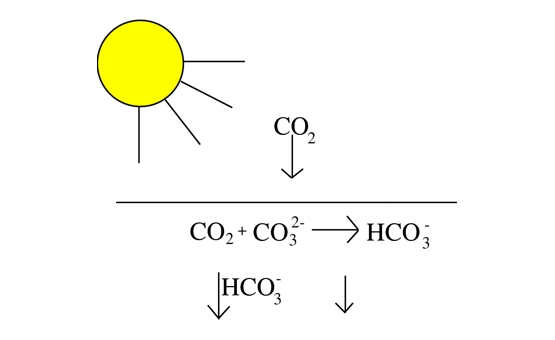PAOC Spotlights
Math, Modeling and the Ocean Carbon Cycle Story
Dr. Anne Willem Omta is a postdoc. in the ocean biogeochemistry group of Mick Follows. He investigates the factors determining how much carbon is stored in the ocean by means of numerical simulations and mathematical theory. Currently, there are large carbon emissions of which a part is taken up by the oceans. Numerical studies indicate that the portion of the carbon emissions being taken up by the oceans will decrease strongly, as emissions continue which could lead to an acceleration of the global warming. Omta et al. explain this decrease in carbon uptake by means of a theory based on elementary carbonate chemistry which is also applied to study the effect of ocean temperature on carbon partitioning.
 The ocean can take up large amounts of CO2, because CO2 reacts with CO32 to form HCO3- (see accompanying schematic). However, the CO32- disappears in this process which diminishes the ocean's uptake capacity of CO2. According to theory, there exists an exponential relationship between total carbon emissions and the amount of CO2 in the atmosphere which is also suggested by simulation results. Furthermore, the theory predicts that the amount of CO2 in the atmosphere increases exponentially with the ocean temperature, again consistent with results from numerical simulations with the MITgcm. This generates a positive feedback: as the ocean warms up, it will take up less CO2, making the warming even stronger.
The ocean can take up large amounts of CO2, because CO2 reacts with CO32 to form HCO3- (see accompanying schematic). However, the CO32- disappears in this process which diminishes the ocean's uptake capacity of CO2. According to theory, there exists an exponential relationship between total carbon emissions and the amount of CO2 in the atmosphere which is also suggested by simulation results. Furthermore, the theory predicts that the amount of CO2 in the atmosphere increases exponentially with the ocean temperature, again consistent with results from numerical simulations with the MITgcm. This generates a positive feedback: as the ocean warms up, it will take up less CO2, making the warming even stronger.
Originally from the Netherlands, Dr. Omta obtained his undergraduate degree in Physics, Meteorology and Physical Oceanography from the Universiteit Utrecht. He did his PhD at the Vrije Universiteit Amsterdam where he worked with H. A. Dijkstra (Universiteit Utrecht). He has been a postdoc in PAOC since 2009.
You can read more about this work in these papers: